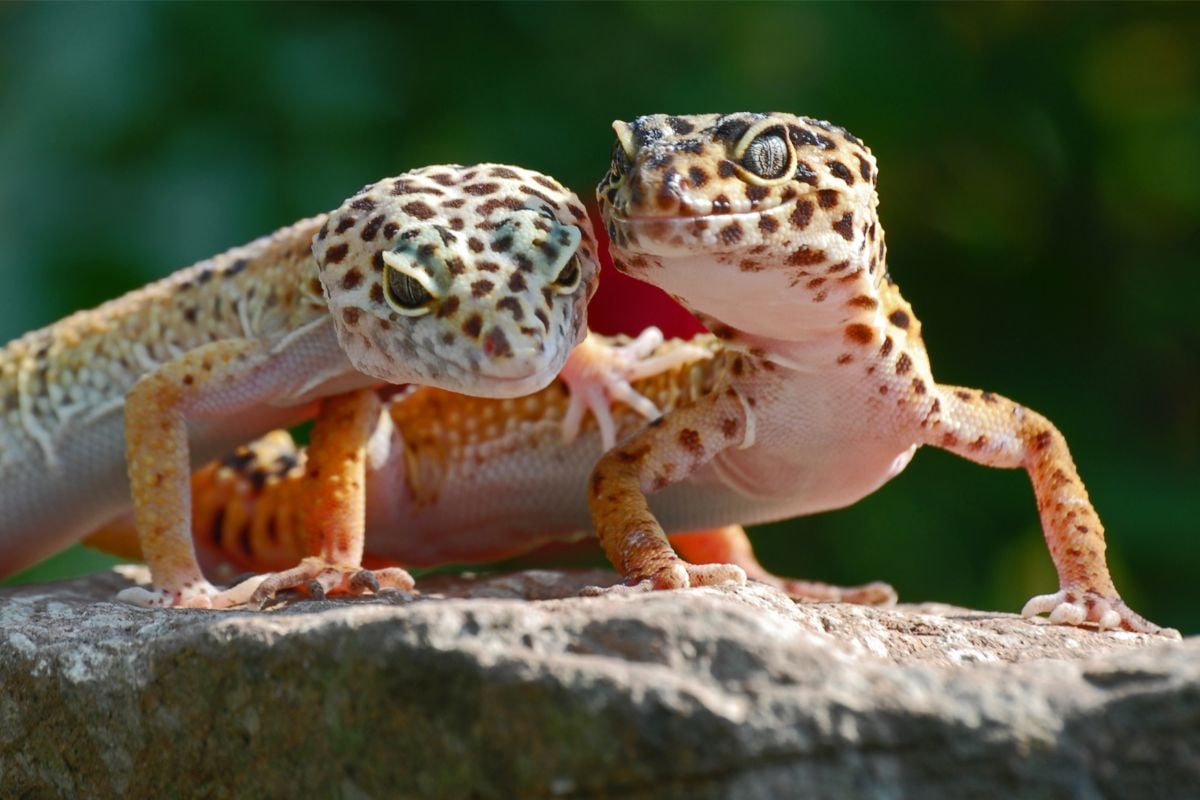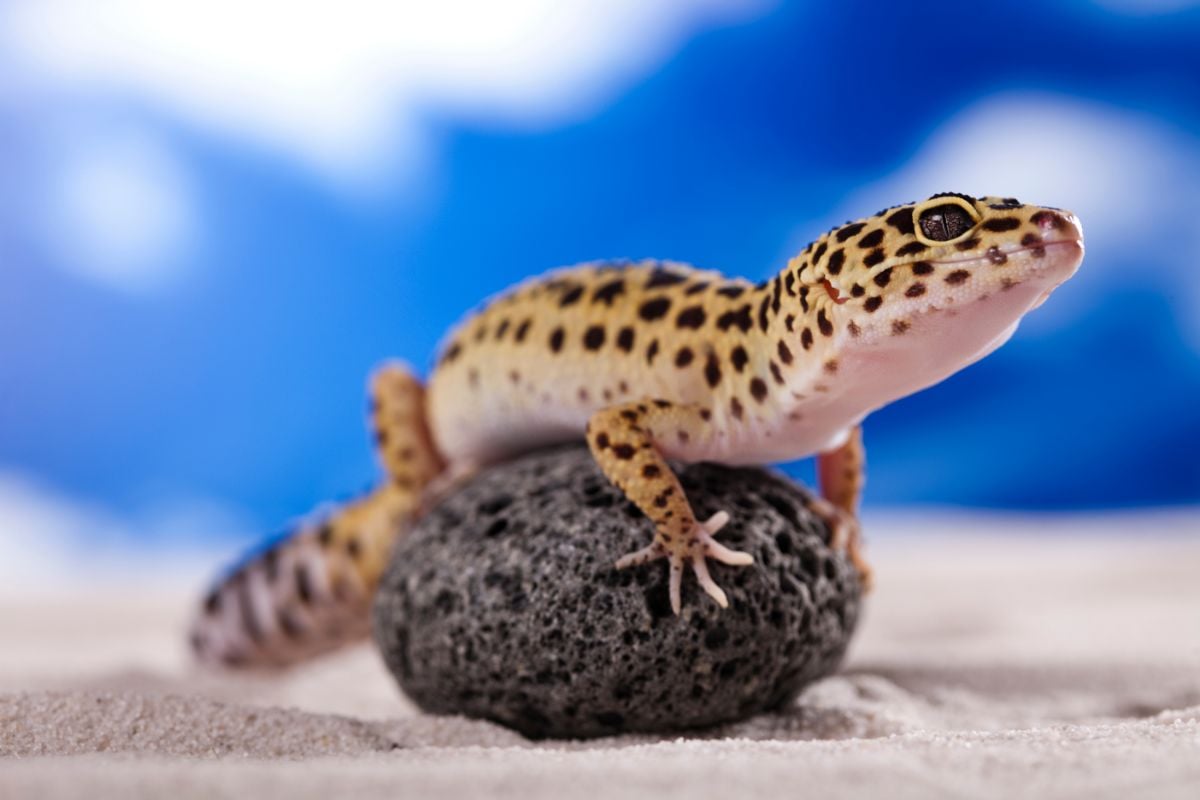The first question any new pet owner asks is how big does their pet grow? It’s a common question for owners of geckos too. After all, how much can you expect your leopard gecko to grow?

Several factors might impact the growth of your leopard gecko. On average, a fully-grown one should measure between 8 and 11 inches. They tend to weigh between 40 and 80 grams too.
Generally, most leopard geckos will reach this length, but remember that females tend to be smaller than males, often measuring between 7 and 8 inches.
How Big is a Baby Leopard Gecko?
Leopard geckos are tiny when they first hatch, measuring between 3 and 4 inches. They usually only weigh between 2 and 5 grams. You must be careful with baby leopard geckos, so you should only keep them in a small container first.
We recommend keeping them in a 10 x 8 inches container so you won’t accidentally lose them. They may also struggle to find their food or water in a larger container. You’ll also need a very shallow water dish, or they might drown due to their small size.
By the time they’re 1 month old, your leopard gecko should be 4 inches, but it will weigh a little more now.
How Big is a Juvenile Leopard Gecko?
A leopard gecko becomes a juvenile at 2 months old. They should be 5 inches long and weigh between 15 and 20 grams. However, they’ll remain like this for a short while.
On average, you can expect your leopard gecko to be between 5 and 6 inches when it’s 6 months old. However, while they might not seem like they’re growing much, they are gaining more weight.
At 6 months old, your leopard gecko can weigh anywhere between 25 and 60 grams. Several factors might impact its growth, but we’ll look at what those factors are later.
Don’t be alarmed if your gecko isn’t 60 grams, as that’s simply the heaviest they should be.
Your leopard gecko will stay classed as a juvenile for another 6 months. However, you’ll notice its growth progress when it’s between 7 and 8 months old.
By then, it should be growing in length and between 6 and 7 inches. Around this point, you can expect them to weigh between 30 and 40 grams.
At this stage, you should be looking into a new enclosure for your gecko. We recommend at least 20 gallons of space, or your leopard gecko may feel uncomfortable.
You don’t want them to feel trapped, so you should move them into a spacier area during this sub-adult stage.
When Does a Leopard Gecko Stop Growing?
You can expect leopard geckos to reach their full size at 18 months old. Around this time, you can expect them to be between 8 and 11 inches long. However, female leopard geckos may be smaller.
You can expect most females to grow to a maximum of 7 or 8 inches and usually weigh between 45 and 70 grams. However, males can expect to reach a weight between 60 and 90 grams.
Likewise, it’s not until they reach this age that your gecko will also reach sexual maturity. However, you shouldn’t let them breed unless they weigh at least 60 grams. Allowing them to breed with another gecko before this age can be dangerous.
What Factors Can Impact Your Leopard Gecko’s Growth?

There may be a few factors that make your leopard gecko smaller than others. Usually, there are around five reasons for this.
Your Leopard Gecko is Getting Bullied
Some leopard geckos may bully others. We recommend not keeping leopard geckos of different sizes in the same enclosure. Larger geckos can seriously injure or even kill smaller geckos.
In all male enclosures, bullying is more likely, so many owners will put a male leopard gecko with other female leopard geckos.
If there is bullying between geckos, they may fight over food and water. Smaller leopard geckos might be unable to access the water bowl, or they won’t get enough food.
Keep an eye on your leopard gecko’s behavior. If there are issues, consider separating them until your smaller leopard gecko is bigger.
Your Leopard Gecko has Nutritional Issues
One of the biggest issues for your leopard gecko’s size is its poor diet. It needs the right nutrients, or it won’t grow properly. You should always feed your leopard on time and ensure you’re feeding it various insects.
Some foods should only be given in moderation, and your leopard gecko should have a varied diet. You want to ensure they get the right supplements to lead to healthy growth.
Unlike other lizards, they’re also insectivores, so you shouldn’t feed them fruit or vegetables as their stomachs can’t process them. You also need to feed them when they’re active so the insects can’t escape from them.
Your Leopard Gecko May Be Transferring Nutrients
If it’s neither of these issues, consider taking your leopard gecko to the vet to see what’s up. Was your leopard gecko ill recently, or did it drop its tail? It might be transferring nutrients to where they’re most needed.
The Temperature is Too Cold
Leopard geckos won’t want to eat when a tank is too cold. They need access to heat to help them digest, so you should always check on the heat levels.
Your Leopard Gecko is Dehydrated
They may also refuse to eat if their water bowl is empty. You should check to see that their bowl is always full of fresh water.
Frequently Asked Questions
Geckos should be fed between 2 or 3 times a week as adults. However, juveniles should be fed every 1 or 2 days.
Conclusion
Leopard geckos come in all shapes and sizes, but you want to ensure they are a healthy size. Ideally, they should be between 8 and 11 inches. If you’re worried about the size of your gecko, check on their surroundings and make sure they’re not getting bullied.
- Can Leopard Geckos Eat Silkworms? - March 11, 2024
- Do Leopard Geckos Climb? - March 4, 2024
- Do Leopard Geckos Bask? The Answer Will Surprise You - February 21, 2024
